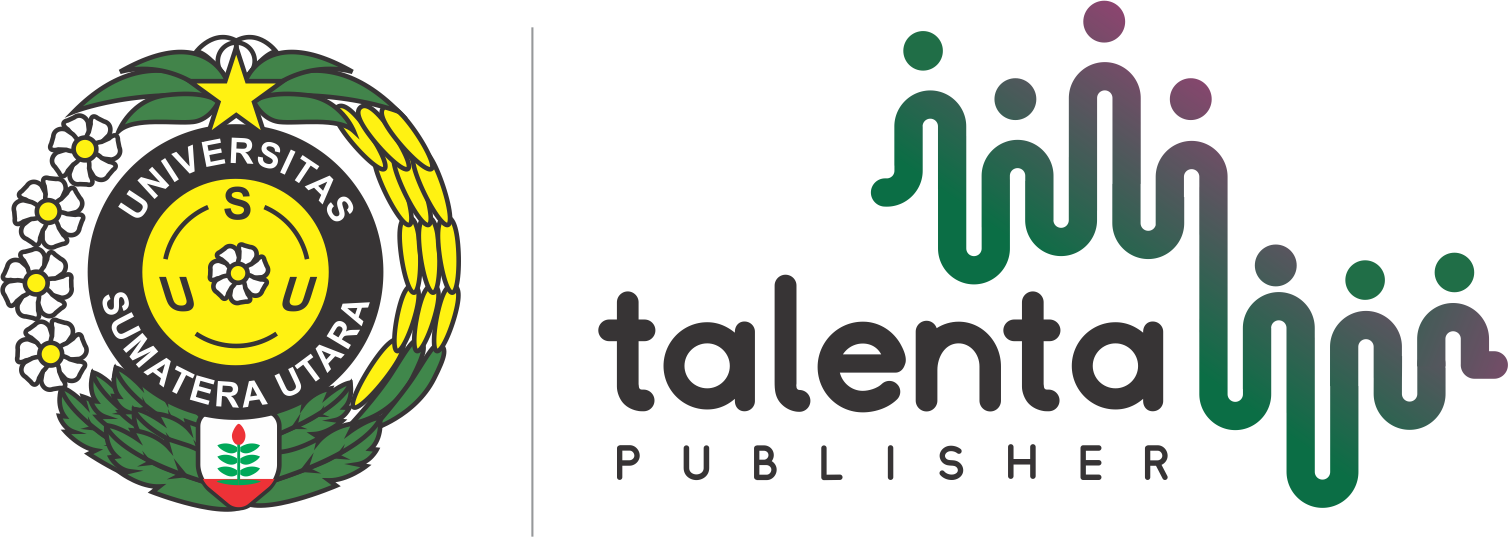Model Forest and Land Fires in Kahayan Central Forest Management Unit
DOI:
https://doi.org/10.32734/jsi.v8i01.15995Keywords:
AHP, Central Kahayan Forest Management Unit, Forest and Land Fire Susceptibility, GIS, PeatlandAbstract
In 2015 and 2019, the Central Kahayan Forest Management Unit (FMU) experienced forest fires on peatlands that had significant impacts on ecological, economic, and social aspects. Consequently, it is imperative to devise a comprehensive strategy aimed at the enhancement of a susceptibility map for forest and land fires. This research endeavor seeks to construct a detailed framework that assesses the susceptibility of forested areas and land to fire incidents inside of the Kahayan Central Forest Management Unit (FMU). The frameworking procedure will employ an integrated approach that synergizes the Analytical Hierarchy procedure (AHP) by Geographic Information System (GIS) technologies to achieve a more robust analysis of fire susceptibility. The outcomes showed that there are three classes of forest and land fire susceptibility, namely the unsusceptible class covering 152,760 hectares (41%), the moderately susceptible class covering 150,171 hectares (40%), and the very susceptible class covering 72,585 hectares (19%). The outcomes of this research are anticipated to provide a foundational framework for the effective management and mitigation of forest and land fires inside of the Central Kahayan Forest Management Unit (FMU), thereby aiming to alleviate the adverse impacts associated by such incidents.
Downloads
References
I. Albar, I. N. S. Jaya, B. H. Saharjo, B. Kuncahyo, and K. P. Vadrevu, “Spatio-temporal analysis of land and forest fires in Indonesia using MODIS active fire dataset,†Land-atmospheric research applications in South and Southeast Asia, pp. 105–127, 2018, doi: https://doi.org/10.1007/978-3-319-67474-2_6.
L. N. Adelia, I. P. A. Shidiq, and F. Zulkarnain, “Identification of forest fire hazard area in Kubu Raya Regency, West Kalimantan Province,†in IOP Conference Series: Earth and Environmental Science, IOP Publishing, 2023, p. 12037.
L. Agustrihardaning, “Assessment of state capacity to manage forest and land fires in Kubu Raya Regency, West Kalimantan Province,†Indonesian Journal of Environment and Sustainable Development, vol. 5, no. 1, 2014.
U. Chokkalingam et al., “Community fire use, resource change, and livelihood impacts: The downward spiral in the wetlands of southern Sumatra,†Mitig Adapt Strateg Glob Chang, vol. 12, pp. 75–100, 2007, doi: https://doi.org/10.1007/s11027-006-9038-5.
Fire Information for Resource Management System, “Active Fire Data.†[Online]. Available: https://firms.modaps.eosdis.nasa.gov/active_fire/
A. N. Ikhsan, D. S. Hadmoko, and P. Widayani, “Spatial Modeling of forest and land fire susceptibility using the information value method in Kotawaringin Barat Regency, Indonesia,†Fire, vol. 6, no. 4. 2023. doi: 10.3390/fire6040170.
M. E. Zulfikar, A. Wibowo, and F. Zulkarnain, “Spatial patterns of forest and land fire hazards using hybrid fire index in Kubu Raya Regency, West Kalimantan Province,†in IOP Conference Series: Earth and Environmental Science, IOP Publishing, 2023, p. 12036.
A. Nurdiana and I. Risdiyanto, “Indicator determination of forest and land fires vulnerability using Landsat-5 TM data (case study: Jambi Province),†Procedia Environ Sci, vol. 24, pp. 141–151, 2015, doi: https://doi.org/10.1016/j.proenv.2015.03.019.
F. Sivrikaya and Ö. Küçük, “Modeling forest fire risk based on GIS-based analytical hierarchy process and statistical analysis in Mediterranean region,†Ecol Inform, vol. 68, p. 101537, 2022, doi: https://doi.org/10.1016/j.ecoinf.2021.101537.
A. Akay and H. Şahin, “Forest Fire Risk Mapping by using GIS Techniques and AHP Method: A Case Study in Bodrum (Turkey),†European Journal of Forest Engineering, vol. 5, pp. 25–35, Jun. 2019, doi: 10.33904/ejfe.579075.
A. E. Akay and A. Erdoğan, “Developing validation of forest fire risk maps based on historical fire incidences,†The International Archives of the Photogrammetry, Remote Sensing and Spatial Information Sciences, vol. 46, pp. 33–38, 2021, doi: http://dx.doi.org/10.5194/isprs-archives-XLVI-4-W5-2021-33-2021.
S. Eskandari, “A new approach for forest fire risk modeling using fuzzy AHP and GIS in Hyrcanian forests of Iran,†Arabian Journal of Geosciences, vol. 10, pp. 1–13, Apr. 2017, doi: 10.1007/s12517-017-2976-2.
S. Chhetri and P. Kayastha, “Manifestation of an Analytic Hierarchy Process (AHP) model on fire potential zonation mapping in Kathmandu Metropolitan City, Nepal,†ISPRS Int J Geoinf, vol. 4, pp. 400–417, Mar. 2015, doi: 10.3390/ijgi4010400.
A. Tiwari, M. Shoab, and A. Dixit, “GIS-based forest fire susceptibility modeling in Pauri Garhwal, India: a comparative assessment of frequency ratio, analytic hierarchy process and fuzzy modeling techniques,†Natural Hazards, vol. 105, no. 2, pp. 1189–1230, 2021, doi: 10.1007/s11069-020-04351-8.
S. Kanga, G. Tripathi, and S. K. Singh, “Forest fire hazards vulnerability and risk assessment in Bhajji forest range of Himachal Pradesh (India): a geospatial approach,†Journal of Remote Sensing & GIS, vol. 8, no. 1, pp. 1–16, 2017, doi: https://doi.org/10.3390/ijgi10070447.
N. Nuthammachot and D. Stratoulias, “Multi-criteria decision analysis for forest fire risk assessment by coupling AHP and GIS: Method and case study,†Environ Dev Sustain, pp. 1–16, 2021, doi: https://doi.org/10.1007/s10668-021-01394-0.
E. Mapilata, K. Gandasasmita, and G. Djajakirana, “Analisis daerah rawan kebakaran hutan dan lahan dalam penataan ruang di Kota Palangka Raya, Provinsi Kalimantan Tengah,†Majalah Ilmiah Globe, vol. 15, no. 2, 2013.
R. Lamat, M. Kumar, A. Kundu, and D. Lal, “Forest fire risk mapping using analytical hierarchy process (AHP) and earth observation datasets: A case study in the mountainous terrain of Northeast India,†SN Appl Sci, vol. 3, no. 4, p. 425, 2021, doi: https://doi.org/10.1007/s42452-021-04391-0.
C. D. A. Tamba, N. N. Debataraja, and D. Kusnandar, “Sebaran spasial titik api berdasarkan penutupan lahan di Provinsi Kalimantan Barat tahun 2020,†Bimaster: Buletin Ilmiah Matematika, Statistika dan Terapannya, vol. 11, no. 4, pp. 629–632, 2022, doi: https://dx.doi.org/10.26418/bbimst.v11i4.57229.
T. T. Tuyen et al., “Mapping forest fire susceptibility using spatially explicit ensemble models based on the locally weighted learning algorithm,†Ecol Inform, vol. 63, p. 101292, 2021, doi: https://doi.org/10.1016/j.ecoinf.2021.101292.
M. A. H. Syam, “Identifikasi tingkat kerawanan kebakaran hutan dan lahan berdasarkan tutupan lahan 2020 dan arahan pola ruang di Kabupaten Wajo,†Universitas Hasanudin , Makasar (ID), 2022.
S. E. Novita and M. Vonnisa, “Pemodelan spasial kerentanan kebakaran hutan dan lahan di Kalimantan Timur,†Jurnal Fisika Unand, vol. 10, no. 2, pp. 232–238, 2021, doi: 10.25077/jfu.10.2.232-238.2021.
A. D. Nurhayati and A. Yusup, “Penyebab kebakaran hutan di Kawasan Hutan Pendidikan Gunung Walat, Jawa Barat,†Journal of Tropical Silviculture, vol. 10, no. 3, pp. 173–177, 2019, doi: https://doi.org/10.29244/j-siltrop.10.3.
D. H. UN and R. Soelistijadi, “Pemanfaatan analisis spasial untuk pengolahan data spasial Sistem Informasi Geografi,†Dinamik, vol. 10, no. 2, 2005, doi: https://doi.org/10.35315/dinamik.v10i2.18.
H. Pratiwi, “Metode Analytical Hierarchy Process,†Research Gate, no. May, pp. 1–33, 2020.
G. M. Foody, “Status of land cover classification accuracy assessment,†Remote Sens Environ, vol. 80, no. 1, pp. 185–201, 2002, doi: https://doi.org/10.1016/S0034-4257(01)00295-4.
H. Abdo, H. Almohamad, A. Dughairi, and M. Al-Mutiry, “GIS-based frequency ratio and Analytic Hierarchy Process for forest fire susceptibility mapping in the Western Region of Syria,†Sustainability, vol. 14, p. 4668, Apr. 2022, doi: 10.3390/su14084668.
S. Samsuri, I. N. S. Jaya, and L. Syaufina, “Model spasial tingkat kerawanan kebakaran hutan dan lahan ( studi kasus Provinsi Kalimantan Tengah),†Foresta Indonesia Journal of Forestry, no. 1, pp. 12–18, 2012.
A. E. Akay and H. Sahin, “Forest fire risk mapping by using GIS techniques and AHP method: a case study in Bodrum (Turkey),†European Journal of Forest Engineering, vol. 5, no. 1, pp. 25–35, 2019, doi: 10.33904/ejfe.579075.
Downloads
Published
How to Cite
Issue
Section
License

This work is licensed under a Creative Commons Attribution-ShareAlike 4.0 International License.



















